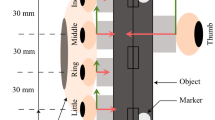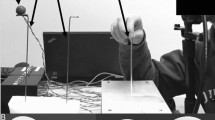Abstract
Human prehension requires accurate information on the properties of an object and on the position of the object relative to the body. In principle, prehension might be more accurate with binocular rather than monocular vision. Previous studies have shown that the kinematics of prehension are altered when one eye is covered. Unfortunately, the source of the useful binocular information cannot be established using this approach. In the current study, we used a perturbation technique to explore whether the human nervous system uses a signal from vergence in prehension. Perturbing vergence caused predictable changes in the kinematics of prehension. Our results thus provide clear evidence that the nervous system uses vergence information in the programming of prehensile movement.
Similar content being viewed by others
Author information
Authors and Affiliations
Additional information
Received: 8 April 1999 / Accepted: 30 June 1999
Rights and permissions
About this article
Cite this article
Mon-Williams, M., Dijkerman, H. The use of vergence information in the programming of prehension. Exp Brain Res 128, 578–582 (1999). https://doi.org/10.1007/s002210050885
Issue Date:
DOI: https://doi.org/10.1007/s002210050885




